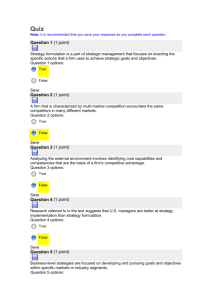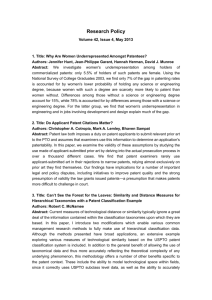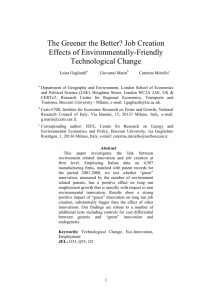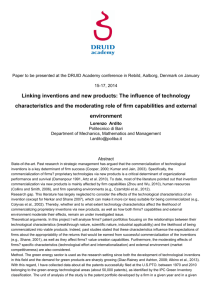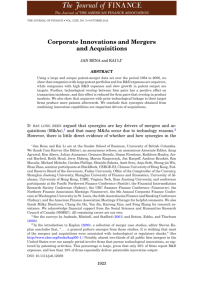Research Policy Volume 44, Issue 7, September 2015 1. Title: How
advertisement
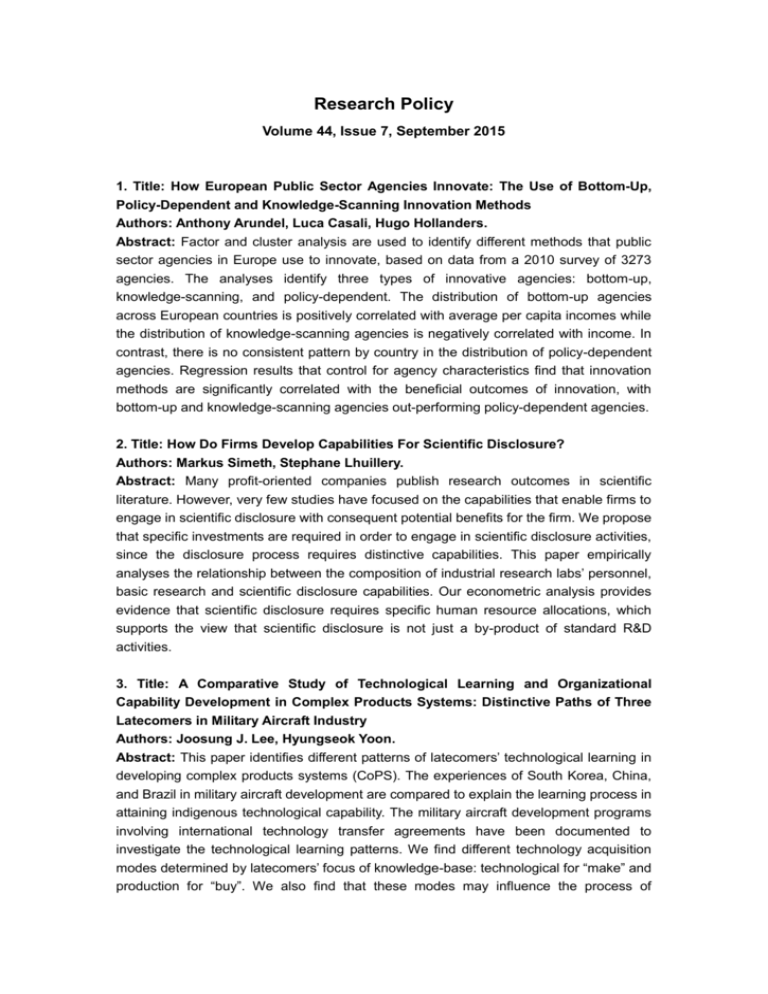
Research Policy Volume 44, Issue 7, September 2015 1. Title: How European Public Sector Agencies Innovate: The Use of Bottom-Up, Policy-Dependent and Knowledge-Scanning Innovation Methods Authors: Anthony Arundel, Luca Casali, Hugo Hollanders. Abstract: Factor and cluster analysis are used to identify different methods that public sector agencies in Europe use to innovate, based on data from a 2010 survey of 3273 agencies. The analyses identify three types of innovative agencies: bottom-up, knowledge-scanning, and policy-dependent. The distribution of bottom-up agencies across European countries is positively correlated with average per capita incomes while the distribution of knowledge-scanning agencies is negatively correlated with income. In contrast, there is no consistent pattern by country in the distribution of policy-dependent agencies. Regression results that control for agency characteristics find that innovation methods are significantly correlated with the beneficial outcomes of innovation, with bottom-up and knowledge-scanning agencies out-performing policy-dependent agencies. 2. Title: How Do Firms Develop Capabilities For Scientific Disclosure? Authors: Markus Simeth, Stephane Lhuillery. Abstract: Many profit-oriented companies publish research outcomes in scientific literature. However, very few studies have focused on the capabilities that enable firms to engage in scientific disclosure with consequent potential benefits for the firm. We propose that specific investments are required in order to engage in scientific disclosure activities, since the disclosure process requires distinctive capabilities. This paper empirically analyses the relationship between the composition of industrial research labs’ personnel, basic research and scientific disclosure capabilities. Our econometric analysis provides evidence that scientific disclosure requires specific human resource allocations, which supports the view that scientific disclosure is not just a by-product of standard R&D activities. 3. Title: A Comparative Study of Technological Learning and Organizational Capability Development in Complex Products Systems: Distinctive Paths of Three Latecomers in Military Aircraft Industry Authors: Joosung J. Lee, Hyungseok Yoon. Abstract: This paper identifies different patterns of latecomers’ technological learning in developing complex products systems (CoPS). The experiences of South Korea, China, and Brazil in military aircraft development are compared to explain the learning process in attaining indigenous technological capability. The military aircraft development programs involving international technology transfer agreements have been documented to investigate the technological learning patterns. We find different technology acquisition modes determined by latecomers’ focus of knowledge-base: technological for “make” and production for “buy”. We also find that these modes may influence the process of learning-by-doing. In addition, we find how the role of foreign partners influences technology acquisition mode. Whereas an active role results in co-production or co-development arrangement, a passive role leads to the vitalization of reverse engineering. We also shed light on the role of government policy initiatives that facilitate technological learning. Lastly, this paper extensively documented the successful technological learning in South Korea’s T-50 and Brazil’s AMX joint venture projects. 4. Title: Impact of Stronger Patent Regimes on Technology Transfer: The Case Study of Thai Automotive Industry Authors: Patarapong Intarakumnerd, Peera Charoenporn. Abstract: This paper illustrates a small extent of co-evolution of IPR regime and technological capability of Thai automotive firms. This study analysed the primary data on Thai IP-related law, regulation, firms’ R&D and innovation surveys, patent registration, court litigation, and conducted interviews for case studies of firms, policy makers, and university professors specialised in the automotive industry. The results show that there are some atmospheric changes in terms of increasing awareness of importance of patent after the regime became stronger. The stronger patent regime has slight impacts on the extent and nature of knowledge transfer between transnational corporations and local part suppliers. Last, the stronger patent regime has impacts on firms climbing up technological ladders from production to more sophisticated activities. 5. Title: Knowledge Stocks, Knowledge Flows and Innovation: Evidence From Matched Patents and Innovation Panel Data Authors: Stephen Roper, Nola Hewitt-Dundas. Abstract: Successful innovation depends on knowledge – technological, strategic and market related. In this paper we explore the role and interaction of firms’ existing knowledge stocks and current knowledge flows in shaping innovation success. The paper contributes to our understanding of the determinants of firms’ innovation outputs and provides new information on the relationship between knowledge stocks, as measured by patents, and innovation output indicators. Our analysis uses innovation panel data relating to plants’ internal knowledge creation, external knowledge search and innovation outputs. Firm-level patent data is matched with this plant-level innovation panel data to provide a measure of firms’ knowledge stock. Two substantive conclusions follow. First, existing knowledge stocks have weak negative rather than positive impacts on firms’ innovation outputs, reflecting potential core-rigidities or negative path dependencies rather than the accumulation of competitive advantages. Second, knowledge flows derived from internal investment and external search dominate the effect of existing knowledge stocks on innovation performance. Both results emphasize the importance of firms’ knowledge search strategies. Our results also re-emphasize the potential issues which arise when using patents as a measure of innovation 6. Title: Determinants of university–firm R&D collaboration and its impact on innovation: A perspective from a low-tech industry Authors: Ornella Wanda Maietta. Abstract: The main aim of the paper is to examine the drivers of university–firm R&D collaboration while at the same time assessing the determinants of innovation in a low-tech industry. This includes analysing firm R&D collaborations with partners different from universities.The paper relies on a unique data-set where firm data were sourced from the Capitalia survey, covering the 1995–2006 years, and the university data were gathered from a number of sources. Result from a multivariate probit model reiterates that university–firm R&D collaboration affects process innovation. Evidence of a more novel kind suggests that product innovation is positively affected by geographical proximity to a university but is negatively affected by the amount of its codified knowledge production. Degree programmes in fields useful for local firms favour R&D collaborations. Academic policies that aim to commercialise research output negatively impact both product and process innovations of local firms. 7. Title: Composition of Inventor Teams and Technological Progress – The Role of Collaboration between Academia and Industry Authors: Friedrich Dornbusch, Peter Neuhäusler. Abstract: It is generally claimed that universities provide the scientific basis for future technological progress. Still, empirical evidence of the impact of direct links between universities and firms remains weak and is often inconsistent. This paper aims at contributing to the literature by analyzing how direct academic involvement affects the output of inventive activities of research teams with different organizational backgrounds. By applying a unique dataset of German academic and corporate patents, we find that boundary-spanning knowledge production with academic inventors raises the innovative performance of SMEs and MNEs. Finally, in line with previous research, the results generally indicate a limiting effect of geographical proximity, while teams with academic involvement appear to be less affected.




